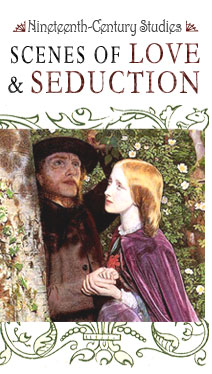Trevor Fisher, from "Introduction: The Mythology of Victorian Values" and Chapter 1, "Women for Sale — The Underbelly of Victorian Respectability" Scandal: The Sexual Politics of Late Victorian Britain (1995)
Transcribed from pages 3 and 8-9 of Trevor Fisher's Scandal: The Sexual Politics of Late Victorian Britain, Phoenix Hill, 1995.
1.
". . . . Writing
in his enormously authoritative
The Family, Sex and Marriage
in England
[Lawrence] Stone argues that the puritanism of the
Evangelical Revival dominated the nineteenth century; by the 1860s, however,
evangelical puritanism was on the wane. Assessing the broad sweep of English
history from 1500 onwards, Stone talks of a
Second phase of repression ... which was
at its peak from about 1800 into the 1860s or later. The tide turned slowly
again. Since then there has developed a second phase of permissiveness,
beginning slowly among the middle classes in the 1870s, and spreading to the
social elite in the 1890s. Then, in the 1920s and more dramatically in the
1960s and 1970s, spreading for the first time to all sectors of the population.
Lawrence
Stone's analysis contrasts sharply with that of Jeffrey Weeks.
Weeks sees little evidence that puritanism was at its strongest in the
mid-nineteenth century, and even less of an ebb and flow of
morality. In his influential
Sex, Politics and Society, he
argues that the nineteenth century witnesses a long and complex battle between
puritanism and libertinism. The forces of puritanism, he contends, gain the
upper hand in the latter decades of the century, and it is only in the twilight
years of Victoria's reign that puritanism becomes sufficiently dominant for its
opponents to be forced to contest 'Victorian values'. In a seminal passage, he
suggests
What seems to be happening in the
nineteenth century . . . is a continuous battle over the definition of
acceptable sexual behaviour within the context of changing class and power
relations . . . there was no blanket imposition of 'repression.' Not till the
1880s did `social purity' have any major legislative purchase. And it is
significant that it is from this period that the earliest critiques of 'Victorianism'
stem.
I agree with Weeks. Far from
the puritan ethic being at its most influential in the middle years of the
century, its influence was far from supreme. In the crucial area of prostitution,
official attitudes were markedly ambiguous. The historically ancient double
standard of morality was deeply embedded in political attitudes, and came close
to being officially sanctioned at the height of Victoria's reign. It is a
telling paradox of Victorian morality that at a time when Victorian
respectability appeared most assured, the government was moving in the
direction of legalizing prostitution and establishing continental-style
state-run brothels" (3).
2.
"The [Saturday] Review took up the classic utilitarian position on the regulation of prostitution, arguing, 'What can't be cured must be alleviated . . . Whatever thins the loose population of the Haymarket and Regent Street is so far a social gain . . . it will not do to attempt a system of prosecuting these vicious places by instalments . . . All immoral houses can be suppressed by the parochial authorities . . . But to carry out the law is simply impossible. What is cut down in one street grows up in the next . . . .' These words were quoted approvingly by William Acton, the leading writer on prostitution of the mid-nineteenth century, who used them as ammunition in a campaign to legalize and regulate prostitution.
Acton was part of a powerful public health lobby, including many in the medical profession, for whom the magazine The Lancet spoke. This body of opinion regarded prostitution and its frequent accomplice, venereal disease, as social problems, not moral issues. Their view was that these problems could only be dealt with by state regulation of prostitutes, as happened in the state-run brothels of countries like Belgium and France. This position was fiercely opposed by the churches and the moral lobby, who upheld the law rendering brothels illegal. But the Saturday Review was right when it said that the law could not be enforced. Female prostitution was endemic in mid-Victorian society, at every level of society from the aristocracy to the lumpenproletariat of London's East End.
If there were any illusions about the vices of London's male élite, they were dispelled by the controversy, in 1862, over the activities of courtesans in Hyde Park. After the success of the Great Exhibition, which was held in Hyde Park in 1851, the park had become fashionable among the rich inhabitants of Belgravia. Riding in the park, particularly along Rotten Row and the Ladies' Mile, became a feature of the Season. Rich young men with a talent for horsemanship took to displaying it in the park, alongside young women of their own class who sought a handsome marriage.
But other women also saw possibilities. Young women of easy virtue who could ride realized that while a prostitute soliciting on foot was anathema in Belgravia, a handsome young woman poised on horseback was socially acceptable. The convention was soon exploited by a group of courtesans, or demi-monde, who became known as 'pretty horse breakers' because in theory they were breaking in horses for rich stable owners (who were little better than pimps). The situation was increasingly unacceptable to respectable opinion. The storm broke in 1862 when Lord Hartington met Catherine Walters.
Catherine Walters, known as 'Skittles,' was a Liverpool prostitute of exceptional good looks, vivacity and riding skills. She had come to London to make her fortune, and after a period patronizing the Argyll rooms, she was hired by a prosperous livery stable owner near Berkeley Square to ride his mounts in Hyde Park, ostensibly to display his horses for sale. She was then in her prime, aged twenty-two. It was while she was playing this role during the spring of 1862 that she met Lord Hartington. Hartington was at that time twenty-eight years old, and the most eligible bachelor in London. He was not particularly handsome or dynamic, but he was outstandingly wealthy. He was the eldest son of the 7th Duke of Devonshire, and in due course would become duke and inherit the Devonshire estates, including the great houses at Chatsworth and Hardwick in Derbyshire.
Such a man was endlessly pursued by ambitious women of his own class, and it may have been the lack of such ambition in Catherine Walters which first attracted him to her. How they met is not known, but she quickly became his mistress. This was not particularly unusual; St John's Wood housed many women discreetly kept by rich men. However, Hartington behaved with extraordinary indiscretion. He installed her in a house in the heart of Mayfair, allegedly bestowed an annual income of 2,000 pounds on her for life, and was seen with her at the Derby that June.
The relationship had become sensational, and became publicly so when, in July 1862, The Times carried an anonymous letter openly wondering who the beautiful young woman (dubbed Anonyma) was who was causing such a sensation in Hyde Park. Ostensibly the author was concerned with traffic congestion.
If this was an attempt at a joke, it quickly backfired. The next day the Daily Telegraph responded with a broadside on behalf of respectability with a leader attacking the situation whereby Hyde Park was 'infested with a number of lewd women . . . well paid by wealthy profligates for selling their miserable bodies' and accusing Anonyma of having 'plenty of fine clothes and sparkling jewels, and a pretty body which she sells to the highest bidder . . . '" (8-10).








